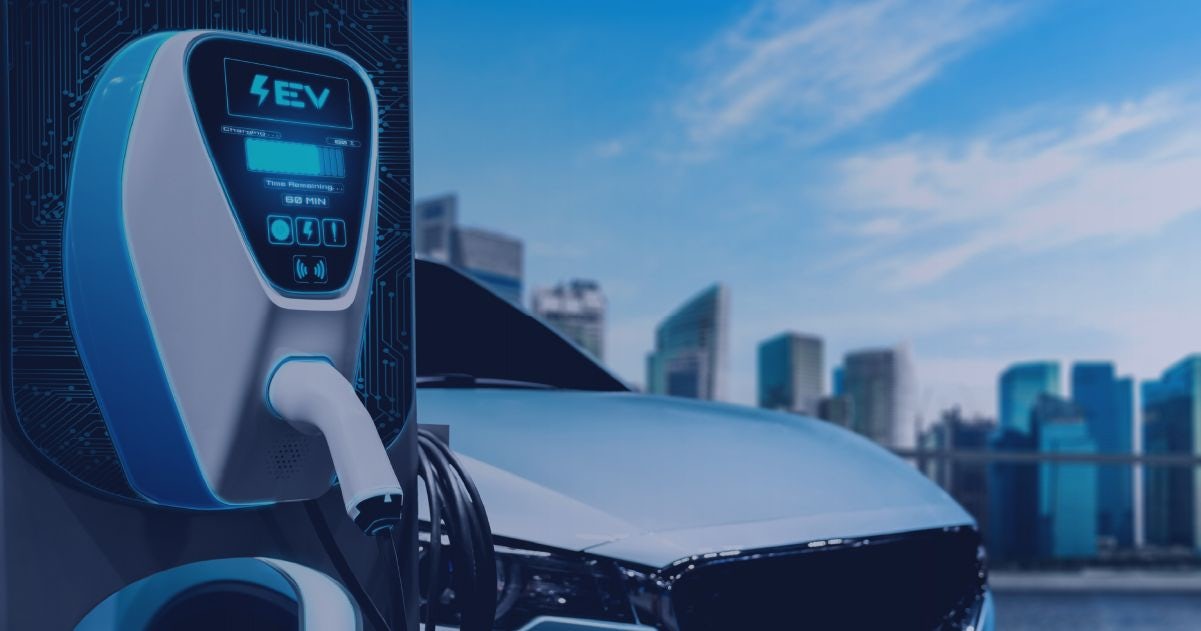Electric vehicles may be the wave of the future, but EV charging stations often give drivers sleepless nights today. That’s because electric vehicle charging infrastructure is often regarded as insufficient or inappropriate in many places around the globe. Luckily, there are exceptions to this rule.
Due to the EV charging network's challenges, many people – be they drivers or environmentalists – wait breathlessly for the newest developments in the electric charging area. And, actually, we all should keep track of them, as the sale of new petrol and diesel cars will be banned in the EU from 2035.
In this article, we’ll present some of the trends and innovative solutions that are already taking EV charging infrastructure to the next level as well as some obstacles it has to overcome. We’ll also mention major electric vehicle types and EV charging infrastructure available as of 2023.
Table of contents:
1. Electric vehicles: overview and types
2. EV 2023 charging infrastructure
3. EV charging stations: benefits and challenges
4. Global EV outlook: 2023 trends
5. Electric vehicle charging infrastructure – key takeaways
Electric vehicles: overview and types
Electric cars – ones that use electricity instead of petrol – are getting increasingly popular, with the world’s plug-in vehicles fleet crossing 20 million units last year. The greater use of EVs is one of the signs of the global switch towards emerging technologies that are reshaping energy systems lightning-fast.
Electric vehicle charging uses some of the most cutting-edge technologies, such as the Internet of Things, Data Science, and advanced data analytics. Solutions such as the battery management system, electric motor, or regenerative braking are also in heavy use.
In brief, emerging technologies drive automotive innovation by making electric cars more lightweight, zero-emission, sustainable, easy to drive, quiet, and responsive. Being technology-driven, EVs can accelerate lightning-fast but maintenance costs tend to be lower than in the case of conventional cars.
Technological innovations also help optimize the grid network, improve battery thermal management systems, and make EVs more autonomous and safer. The bottom line is accelerating mass-market adoption of electric cars – they come with more and more cutting-edge features and more and more people want to give them a try.
There are three main types of electric vehicles:
Battery Electric Vehicles (BEVs)
Also known as All-Electric Vehicles, BEVs are zero-emissions vehicles (ZEVs) that are fully electric. They don’t have a gasoline engine which makes them not only eco-friendly but also quiet – due to the lack of internal combustion noise.
Battery electric cars run on electricity only and are powered solely by electric batteries which require charging. BEV examples include Nissan Leaf, Tesla Model 3, Tesla Model Y, Hyundai Ioniq 5, Kia e-Niro, Renault Zoe, and TATA Nexon.
Plug-in Hybrid Electric Vehicles (PHEVs)
With both a petrol engine and a battery on board, PHEVs offer flexibility to use both options. At the beginning of the trip, the battery can be in use, but when it gets discharged, the driver doesn’t have to look for a charging point for electricity but may head to a petrol station for fuel instead.
Overall, a PHEV provides fuel efficiency, and when it comes to battery charging, this can be done either by plugging into the external source of electricity, or regenerative braking. PHEV examples are Mitsubishi Outlander, Toyota RAV4, Fiat 500e, Audi A3 E-Tron, Hyundai Sonata, Kia Optima, and Toyota Prius.
Hybrid Electric Vehicles (HEVs)
A Hybrid Electric Vehicle takes all needed energy from gasoline and can be referred to as „an automobile or other vehicle that is powered by an internal-combustion engine and an electric motor whose battery is charged by the engine and by regenerative braking that converts the vehicle's kinetic energy into electricity”.
The small battery HEVs are equipped with cannot be charged but may be sufficient for the car to run on it alone when the speed is low. HEVs are known for offering fuel savings and good fuel efficiency. Some examples are Toyota Prius (the world’s all-time top-selling hybrid), Kia Optima Hybrid, Toyota Yaris Hybrid, Ford Mondeo Hybrid, and Lexus NX.
EV 2023 charging infrastructure
EV charging infrastructure is all about charging stations.
An electric vehicle charging station, also known as electric vehicle supply equipment (EVSE), can be defined as „equipment that connects an electric vehicle to a source of electricity to recharge electric cars, neighborhood electric vehicles and plug-in hybrids.” by connecting it to the power source.
A typical charging station uses a socket outlet placed on the EVSE to supply charging power to the vehicle via a cable, equipped with a plug on one end and a connector on the other that passes the power to the car through the vehicle inlet. On the other hand, the components of a home charging system include a charging station, an on-board charger, and a battery.
There are AC and DC chargers in use as of 2023. AC chargers are commonly used both at homes and in public charging stations. They are cheaper to use but slower and need an external DC converter. DC fast chargers, which can be found at DC fast charging stations, are more costly but offer a power of 50-100 kW per km/h, about twice as much as AC chargers.
EV charging stations: benefits and challenges
The switch to electric vehicles has its reasons. EVs’ avid supporters praise them for:
- money savings on fuel costs (on average, $700 per year in the US),
- lower maintenance,
- enhanced driver experience with reduced noise levels and faster acceleration.
Other advantages are:
- sustainability,
- being environmentally friendly,
- helping community members breathe fresh, unpolluted air.
But there’s even more.
Interestingly, electric vehicles tend to be safer than their conventional counterparts, with the rates of injury claims more than 40% lower, as the data examined by the Insurance Institute for Highway Safety showed.
All the benefits using EVs brings to societies and economies make many authorities promote it heavily. One of the cities with such incentives offered is London, where they cover things like tax benefits, grants for new plug-in vehicles, and free or reduced-charge parking for EVs in some boroughs.
On the downside:
- electric cars are still offered in limited selections,
- the initial cost of buying an electric vehicle is relatively high.
But many people don’t even consider switching to an electric car for another reason – and that is range anxiety. In brief, that’s the driver’s fear that the car they’re in won’t be able to reach the destination due to insufficient energy storage.
Of course, this fear can have its justification as the charging infrastructure has its problems, too:
- accessibility – the number one challenge is making EV charging more accessible for people and increasing public charging resources,
- battery charge time – another challenge is the charging speed which, although improving, may not be in line with the fast-paced lives many people still have.
The last challenge that the EV world has to face is addressing the above-mentioned issues. In many places around the globe, these problems are huge pain points and obstacles in fast development of the EV network. That’s why, solving them is at the heart of the newest trends in the area.
Global EV outlook: 2023 trends
As far as the EV 2023 trends are concerned, almost everything can be boiled down to EV infrastructure development and improving the access to EV chargers – and thus making a plug-in vehicle operation easier, more convenient, and cheaper. Increasing energy efficiency, and improving energy management are important, too.
Trend 1: Interoperability improvement
Being able to use any charger is a desire of many EV drivers and being unable to do so has been a major obstacle on the way to electric charging development. But more and more drivers can charge their plug-in cars – and pay for it – at each and every charging station.
The answer is the availability of an IT-based open network for station interoperability. The possibility to use charging stations across providers and platforms is supported by an internationally-recognized Open Charge Point Protocol with organizations from all over the world participating.
Trend 2: Accessibility increase
Interoperability enhancement is one of the initiatives to make EV infrastructure more accessible. Others are the spread of smart charging and public charging, but also residential charging stations that let users charge their EV cars at home, preferably with a wallbox charger. And these efforts bring tangible effects.
For instance, the UK saw an impressive 35% annual increase in the total number of charging devices since March 2022. As of March 2023, drivers traveling across the country can use over 40,000 electric vehicle charging points available in nearly 24,000 charging locations within the country’s public EV charging infrastructure. The bottom line is that the current UK map of electric car charging points looks truly impressive.
Trend 3: EV charging maps enablement
The number of interactive maps showing where you can charge your plug-in car is on the sharp rise, too. They are provided by various entities, including local or state authorities, institutions, or particular automotive brands to make EV car drivers feel more comfortable and secure before hitting the road.
These maps can be limited to this particular brand’s charging points, present public EV charging infrastructure in a certain country, or show what things look like worldwide, which can be useful, e.g., when you’re planning to travel abroad. The world-encompassing charging infrastructure map can be found here.
Trend 4: EV home chargers development
There are countries where the vast majority of electric car charging is made at home. In the US, a staggering 80% of EV users choose home as the charging location. The number of available home charging stations grows fast, and they can be either portable or mounted to a wall.
Some EV chargers can handle extreme weather conditions and are proper for people who park their electric cars in the street. However, in the case of multi-family housing, it may be impossible to use a home charging station. It’s one of the reasons why improving the network of public charging stations is necessary, too.
Trend 5: Looking for innovative features
EV charging infrastructure tends to get more sophisticated and offer more and more innovative approaches. The urge to create a better, supercharging battery, preferably with the use of silicon – through the industry’s joint effort – is definitely in the cards for 2023.
Areas that may be further developed cover:
- open network interconnectivity,
- wireless charging, in-pavement charging,
- lamppost charge points,
- vehicle-to-grid (or bidirectional charging),
- smart metering,
- using wind or even tidal power.
Electric vehicle charging infrastructure – key takeaways
Numerous benefits of EVs make their common use something worth fighting for. But to make the EV revolution complete, it has to be easy to charge them whenever needed, and not when the insufficient infrastructure enables that. A charging station simply needs to be around the corner or even at home, to make a difference.
And that’s the case in the UK, where there are already more public EV charging stations than petrol stations. And, on top of the country’s public EV charging infrastructure, there are over 400,000 charge points installed at home or at workplace locations – with a lower cost to charge an electric car.
Other countries will inevitably follow, supporting sustainability, fighting air pollution, and bringing money savings to plug-in car drivers. Current EV charging infrastructure trends will certainly strengthen the electric cars’ market position, despite charging access concerns, or battery storage issues we still see today.
Want to know more about the technology or software side of using EV charging infrastructure or other modern energy systems? If you need advice on how to expand your business in this area with the use of emerging technologies, contact Codete now.


